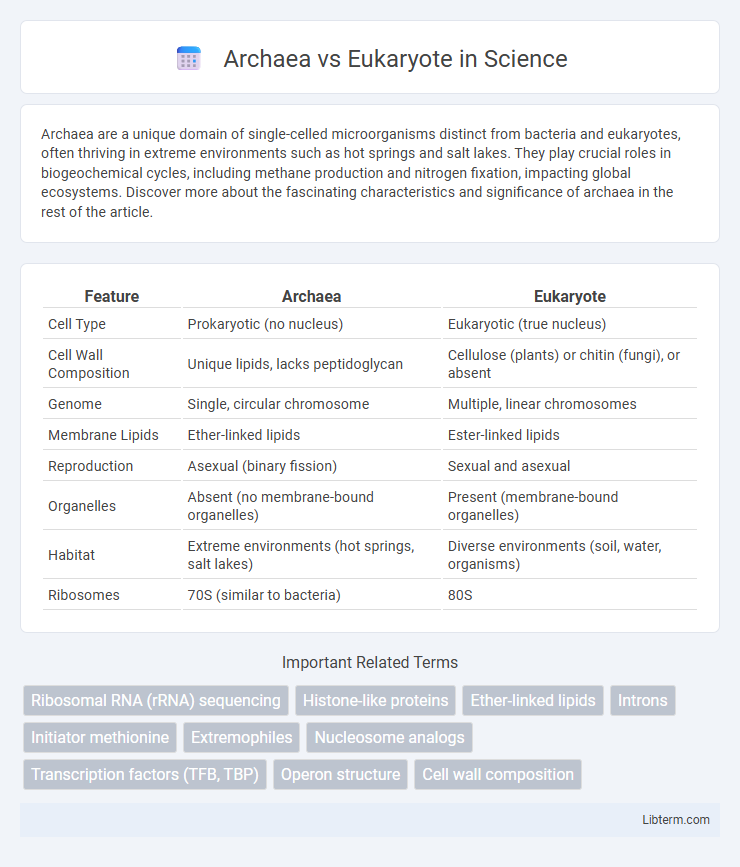Archaea are a unique domain of single-celled microorganisms distinct from bacteria and eukaryotes, often thriving in extreme environments such as hot springs and salt lakes. They play crucial roles in biogeochemical cycles, including methane production and nitrogen fixation, impacting global ecosystems. Discover more about the fascinating characteristics and significance of archaea in the rest of the article.
Table of Comparison
| Feature | Archaea | Eukaryote |
|---|---|---|
| Cell Type | Prokaryotic (no nucleus) | Eukaryotic (true nucleus) |
| Cell Wall Composition | Unique lipids, lacks peptidoglycan | Cellulose (plants) or chitin (fungi), or absent |
| Genome | Single, circular chromosome | Multiple, linear chromosomes |
| Membrane Lipids | Ether-linked lipids | Ester-linked lipids |
| Reproduction | Asexual (binary fission) | Sexual and asexual |
| Organelles | Absent (no membrane-bound organelles) | Present (membrane-bound organelles) |
| Habitat | Extreme environments (hot springs, salt lakes) | Diverse environments (soil, water, organisms) |
| Ribosomes | 70S (similar to bacteria) | 80S |
Introduction to Archaea and Eukaryotes
Archaea are single-celled microorganisms that thrive in extreme environments and possess unique genetic and biochemical traits distinct from bacteria and eukaryotes. Eukaryotes, characterized by membrane-bound organelles and a defined nucleus, encompass diverse life forms including animals, plants, and fungi. The fundamental differences in cellular structure and genetic makeup between Archaea and eukaryotes highlight their distinct evolutionary paths within the tree of life.
Defining Cellular Structure Differences
Archaea possess unique membrane lipids composed of ether-linked isoprenoids, contrasting with the ester-linked fatty acids found in eukaryotic membranes. Unlike eukaryotes, Archaea lack membrane-bound organelles such as mitochondria and a defined nucleus, featuring instead a nucleoid region with circular DNA. Ribosomal RNA sequences and protein synthesis machinery in Archaea also exhibit significant differences, reflecting their distinct evolutionary lineage from eukaryotes.
Genetic Material and Genome Organization
Archaea possess circular DNA genomes organized into a single chromosome with histone-like proteins, contrasting with eukaryotes that feature multiple linear chromosomes wrapped around canonical histones within a nucleus. Archaeal genetic material replicates using a combination of bacterial and eukaryotic-like mechanisms, including unique origin recognition complexes, whereas eukaryotic genome replication involves complex origin licensing and multiple origins of replication per chromosome. Genome organization in archaea is more compact with fewer non-coding regions and operon structures, while eukaryotic genomes contain extensive introns, repetitive elements, and a higher level of chromatin remodeling and epigenetic regulation.
Membrane Composition: Lipids and Proteins
Archaea possess unique membrane lipids composed of ether-linked isoprenoid chains, which provide increased stability in extreme environments compared to the ester-linked fatty acids found in eukaryotic membranes. Archaeal membranes often feature monolayer or bilayer structures with distinctive glycerol-1-phosphate backbones, contrasting with the glycerol-3-phosphate backbone in eukaryotes. Membrane proteins in archaea exhibit adaptations for extreme conditions, including enhanced thermostability and distinct structural motifs, differing significantly from the integral and peripheral proteins characteristic of eukaryotic membranes.
Unique Metabolic Pathways
Archaea possess unique metabolic pathways such as methanogenesis, a process absent in eukaryotes, allowing them to produce methane from substrates like carbon dioxide and hydrogen. Their lipid membranes contain ether-linked isoprenoids, contributing to stability under extreme conditions, contrasting with the ester-linked fatty acids found in eukaryotic membranes. Eukaryotes utilize complex aerobic respiration involving mitochondria, while many archaea rely on diverse anaerobic pathways adapted to extreme environments.
Environmental Adaptations and Habitats
Archaea thrive in extreme environments such as hydrothermal vents, acidic hot springs, and hypersaline lakes, exhibiting unique biochemical adaptations like ether-linked membrane lipids that enhance stability under extreme temperatures and pH levels. Eukaryotes inhabit a broader range of environments, from terrestrial to aquatic ecosystems, utilizing membrane-bound organelles that support complex metabolic processes and facilitate adaptation to variable conditions. Archaea's ability to metabolize energy from inorganic compounds enables survival in anaerobic and chemically harsh habitats, contrasting with the predominantly oxygen-dependent metabolism of eukaryotes.
Reproduction and Cell Division Mechanisms
Archaea reproduce primarily through binary fission, a simple asexual process where the cell divides into two genetically identical daughter cells, lacking the complex mitotic machinery characteristic of eukaryotes. Eukaryotes exhibit both mitosis and meiosis, allowing for an intricate cell division process that supports sexual reproduction, genetic diversity, and multicellularity. The presence of a well-defined nucleus and membrane-bound organelles in eukaryotes facilitates organized chromosome segregation, unlike the more streamlined and less compartmentalized mechanisms in Archaea.
Evolutionary Relationships and Origin
Archaea and eukaryotes share a closer evolutionary relationship due to their similar molecular machinery, such as RNA polymerases and ribosomal proteins, which differ significantly from those in bacteria. Comparative genomics suggest that eukaryotes originated from an archaeal ancestor, specifically within the Asgard archaea superphylum, through symbiotic events that integrated bacterial endosymbionts. This chimeric origin highlights the complex evolutionary processes involving gene transfer and cellular fusion that underpin the emergence of eukaryotic cells.
Key Roles in Ecosystems
Archaea play crucial roles in extreme environments by driving biochemical cycles such as methanogenesis and sulfur reduction, essential for nutrient recycling and energy flow. Eukaryotes dominate diverse ecosystems through complex food webs, contributing to primary production, decomposition, and habitat formation. Both Archaea and Eukaryotes are integral to global biogeochemical processes, maintaining environmental balance and supporting life sustainability.
Biotechnological and Medical Relevance
Archaea possess unique enzymes such as thermostable DNA polymerases, extensively utilized in PCR techniques within biotechnology and medical diagnostics due to their stability under extreme conditions. Eukaryotes, encompassing human cells and model organisms, provide critical platforms for drug development, gene therapy, and recombinant protein production. Understanding the distinct cellular mechanisms of archaea and eukaryotes enables advances in synthetic biology, novel antimicrobial discovery, and personalized medicine applications.
Archaea Infographic

 libterm.com
libterm.com